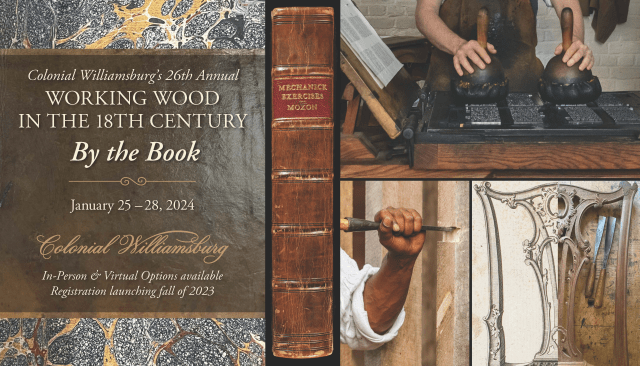
The following is excerpted from “Honest Labour: The Charles H. Hayward Years.”
When we started on The Woodworker project more than a decade ago we didn’t intend to publish “Honest Labour.” The series was going to have four books that covered handwork: Vol. 1: Tools; Vol. 2: Techniques; Vol. 3: Joinery; and Vol. 4: The Shop & Furniture. But as we paged through every article from The Woodworker during the 30-year period, we kept getting stuck on the “Chips From the Chisel” column at the beginning of every issue.
These columns during the Hayward years are like nothing we’ve ever read in a woodworking magazine. They are filled with poetry, historical characters and observations on nature.
This column was first published in a 1936 issue of The Woodworker; it remains relevant today for woodworkers old and new.

Are you finding woodworking as easy as you thought? Or is your ardour being cooled by disappointment? If you have not encountered any serious set-back you are indeed fortunate. If you have, don’t worry; take heart—and the advice below.
Think It Out
One thing is certain: that, even though the craft is a lifetime’s study, the application of a few simple principles will assuredly bring success in woodworking. In the first place, never start a job until you know precisely how you are going to do it. Pass its construction step by step through your mind, so that you may hit upon the snags and mentally smooth them out. Making full- size working drawings is part of this thought-before-doing process. It compels you to think out your construction. Besides, full-size drawings are an aid (sometimes an indispensable aid) to setting out, and you need all the aids you can get.
Be Thorough
Don’t work hurriedly. Your very keenness may prompt you to rush, but to do so is fatal. Curb your desire to see the thing finished, and always concentrate intently upon the particular bit of the job you have in hand. The trueing up of work in preparation for setting-out may strike you as irksome, but it forms the foundation upon which you build. Therefore do it well. See that you have on every piece of wood a face side and edge, and that each piece is truly gauged and planed to width and thickness. Reject twisted stuff; if you use it, it will only give trouble later.
With your well-prepared material, you are well started and ready for setting-out. This is not the marking-time process it seems to be. Actually, during set-ting out, the work is going forward quite rapidly. You are indeed casting the die of the whole job. It is at this stage that your full-size drawing proves useful. Avoid the risk of relying too much on the rule, as this leads to inaccuracies, and when-ever possible apply your wood to the drawing, ticking off the points as need be. When two or more pieces are to be marked alike, set out one from the drawing, then cramp the others to it, and so mark them all. Door stiles and rails, for instance, should always be treated like this and never marked separately. Keep your pencil sharp, and always draw fine distinct lines, not thick ones. When set-ting out, always take care to arrange any necessary pairing of pieces.
Be Accurate
In all you do be accurate. No measurement, no cut, no squaring, should be “near enough.” It must be right. For often one inaccuracy becomes the seed of others, and reproduces trouble as the work proceeds. Remember that the secret of the successful joint is to cut just on the waste side of the lines. If your joints do not fit right away, take your time and much care in making them fit, but tread warily; it is very easy to ruin a joint when fitting.
Unless your job is of the simplest, you may find yourself stuck over some point of construction or procedure, in which case put down your tools and think, or consult someone who knows. What-ever you do, re-start only when the way is clear. Look to the state of your tools. With a blunt chisel or gouge good work is impossible; and such a tool, because of its tendency to slip, is dangerous to use. Chisels and plane irons need sharpening much more frequently than you may think. Don’t spare your oil-stone. Rather err on the side of too frequent sharpening. The craftsman always does; and if this helps him, it will help you. It is wise to have your saws sharpened and set professionally. If properly done, they should need attention only rarely.
Clean Up Well
Be particular about the contents of your glue-pot. Throw away stale glue that has been heated many times and has therefore deteriorated, and substitute fresh. Keep it at the consistency of paint, and don’t forget that, because of the evaporation of the water, glue is thickening all the time it is being heated. When thinning, use hot water. Do your glueing in a warm atmosphere, away from draughts, and be smart about it. Be liberal with the glue, but keep it from running and setting in places from which it will be difficult to remove.
Should cleaning up trouble you, bear this in mind: that every surface to be cleaned up must be levelled off (if need be) and made quite flat and more or less smooth with the jack plane or the jack and trying planes. Only on such a surface will a fine-cutting smoothing plane work.
Finally, don’t worry about an honest mistake. Ponder the reason for it and so learn from it. Progress at your own speed from simple job to something more difficult, but never force the pace. At the same time, be just as ambitious as your previous work warrants.








